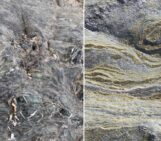
While drowning bacon in maple syrup, Eduardo has been wondering:
Which rheology best describes the mantle?
Dear Eduardo,
You sound like a numerical modeller to me: someone who wants an equation (and one that actually works on top of it!) to describe the rheology of 84% of Earth’s total volume. You seem to seek one glove that fits all, and I am afraid to disappoint, but our planet does not work this way. However, as it is widely known by know, I am a source of great wisdom and all answers!
As many things on our planet the short answer is: we don’t really know. And the long answer is: depends where you look and over which time-scale you seek an answer. The best place to think about rheology is… the kitchen! Go and shake some ketchup and stir some corn starch in water for some non-Newtonian fun. The next level is to think about different parts of the mantle under different temperature and stress conditions and how they might rheologically interact. Take a seat and have some crème brûlée or a jelly sandwich, or better yet, a banana split. We all know mushroom-like thermal anomalies are a big deal in the whole ‘mantle thing’, so why not make yourself a delicious wild mushroom stew while you’re at it?
As things in science go, the answer to such a broad question varies with the academic providing it. You are of course in great hands, as I am the sole beholder of the truth. But in this case, the truth is that your question is rather ill posed. We all fall into the trap of asking questions that lose nuance. Here are some fun things to think about and ask academics at conferences and see them getting all worked up: Do we even need anything beyond diffusion and dislocation creep in geodynamic models of the mantle? Does anything else besides olivine actually matter for simulations of long term mantle flow? Doesn’t water weaken everything anyway? How does grain size influence mantle rheology and why do we even care?!
Yours truly,
The Sassy Scientist
PS: Cornbread would work amazing with that wild mushroom stew!





